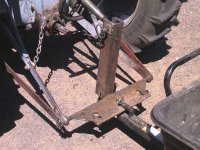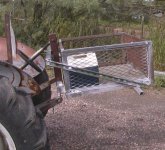Howdy folks. Well I'm taking the plunge and moving up from a GT to a CUT. Got a nice deal on a MF 1205, but now I need to get up to speed on working with and maintaining a larger tractor with 4wd and a diesel engine. I won't take delivery of the tractor and its accompanying manuals until April, but I wanted to start getting an idea of what sorts of things I'll need to know to keep this thing in good operating condition.
All my life I've worked with gas engines, so I'm comfortable maintaining, troubleshooting and repairing them, but I know nothing when it comes to diesel engines or 4 wheel drive tractors.
Regarding the diesel engine - Do the glow plugs need to be replaced often like spark plugs? I get the impression that they don't actually function the way spark plugs do, but don't really know wha their lifespan is.
How do you properly maintain a radiator and liquid cooling system?
What cold weather provisions do I need to make to keep a diesel tractor running? Do I need a block heater, or could I just use a heat gun on the engine if I ever encounter a day that's too cold.
Is it best to leave a diesel running, or can I turn on and off the engine like a gas tractor? (for example, if I'm loading a trailer with yard debris and have to make multiple trips to clean it al up, is it best to let the engine run for the 5 minutes everytime I'm loading the trailer , or can I shut it down?)
Regarding 4WD - can I just put chains on the rear tires, or do I need to put chains on all four tires?
When using the FEL, to minimize wear and tear on the front end, how big a counterweight should I hang from the 3 pt to keep the tractor balanced? Is it supposed to match the max load that the FEL can handle?
Finally, I've seen some counterweights that people made to hang off the 3PH using a small barrel filled with concrete. Does anybody know what they used for the pins that pass through the barrel? I made one for the Cat 0 3PH on my GT using a 5 gallon pail and some threaded rod, but the threaded rod seemed to chew up the ball links on the hitch.
Thanks for any isight you can give me on this stuff.
HB
All my life I've worked with gas engines, so I'm comfortable maintaining, troubleshooting and repairing them, but I know nothing when it comes to diesel engines or 4 wheel drive tractors.
Regarding the diesel engine - Do the glow plugs need to be replaced often like spark plugs? I get the impression that they don't actually function the way spark plugs do, but don't really know wha their lifespan is.
How do you properly maintain a radiator and liquid cooling system?
What cold weather provisions do I need to make to keep a diesel tractor running? Do I need a block heater, or could I just use a heat gun on the engine if I ever encounter a day that's too cold.
Is it best to leave a diesel running, or can I turn on and off the engine like a gas tractor? (for example, if I'm loading a trailer with yard debris and have to make multiple trips to clean it al up, is it best to let the engine run for the 5 minutes everytime I'm loading the trailer , or can I shut it down?)
Regarding 4WD - can I just put chains on the rear tires, or do I need to put chains on all four tires?
When using the FEL, to minimize wear and tear on the front end, how big a counterweight should I hang from the 3 pt to keep the tractor balanced? Is it supposed to match the max load that the FEL can handle?
Finally, I've seen some counterweights that people made to hang off the 3PH using a small barrel filled with concrete. Does anybody know what they used for the pins that pass through the barrel? I made one for the Cat 0 3PH on my GT using a 5 gallon pail and some threaded rod, but the threaded rod seemed to chew up the ball links on the hitch.
Thanks for any isight you can give me on this stuff.
HB

